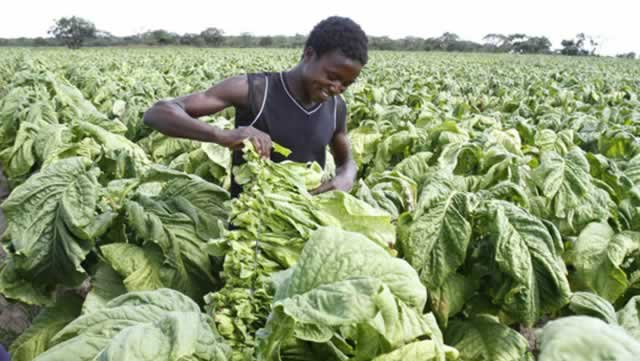TSL revenue goes up 19 percent

TSL has said it will continue to focus on creating sustainable value through its clusters after the group reported a 19 percent increase in revenue in the year to October.
Chief executive Washington Matsaira told analysts last week that there were good prospects for growth in the established clusters. In logistics, the group was in the process of acquiring a complementary business, deepen the distribution service offering and to introduce new services such as rail.
“In fact, a pilot rail project, where the group moved 20 000t of fertiliser from Beira was successful.”
Mr Matsaira also said that the group would look beyond tobacco and have a well planned entry into other agricultural commodities. “We will however continue to focus on activities that incorporate value addition and exports.”
He however added that all this would be possible if the group aligns its plans with an appropriate funding structure in terms of tenure and cost.
At Properties, the group would make optimal use of existing space by introducing racking while there would also be an increase in third party tenancy.
“Adding to that, we are currently doing feasibility work for an Industrial Park at the Vostermans Property (near the Granville Cemetery). This is however not a short term project but we are excited all the same as it offers an opportunity for the group to unlock value. Overall, we have very interesting prospects which fit well with the handling capacity.”
TSL maintained a stable growth in their business anchored by spiking tobacco and logistics businesses. In the full year financials to October 2014 the group recorded a 19 percent increase in revenue from the comparable year to $48,16 million.
Operating profits however grew at a slower rate of 4 percent to $7,3 million due to a drop in Port volumes which traditionally offers higher margins. Profit before tax came in lower at $6,8 million and was attributable to a decline in associate companies’ profitability and a non recurring downward property revaluation. Headline earnings were up 10 percent to 1.71c.
The logistics business, which is its linchpin, recorded a 7 percent gain in revenues to $19,1 million. The logistics sector’s contribution represented 40 percent of the total turnover achieved.
Premier Forklift which was acquired in the preceding year for a consideration of circa $2,7m has started generating positively to the group’s revenues as well as profitability. Mr Matsaira highlighted that efforts to expand the customer’s base are underway, a move that will boost revenues in the current financial year. In the period under review Tobacco operations’ revenue grew by 16 percent to $13,801,780m buoyed by a bumper tobacco crop while underpinned by a 50 percent market share.
Analysts comment
TSL is well positioned to survive and thrive in a cash-constrained environment. While the devil is in the detail, the group on the surface of it operates strong SBUs that have potential to grow. After management changes, the business got off to a good start beating expectations and registering strong growth between 2012 and 2013.
The steam seems to have run out with the company failing to break some resistance at the $100 million barrier. A number of reasons are the major cause and chief among them failure to improve on the business’ operating profitability. As in previous years, the business continues chewing at its bottom line with spiralling costs. Management have to realise that there is need to rationalise costs and possibly take advantage of the synergies that exist within the group.
This could be done by combining some business functions to limit overheads. The idea of creating more clusters will result in a more bloated structure that will increase cost pressures for the group.
The last time we spoke about TSL we commended the group for a new approach to their business model that saw the structuring of the SBUs into more focused units. We also mentioned the need to unlock value in the group’s properties unit. A lot of things have happened since then, some good and a few bad.
We believe the management deserves a slight slap on the wrist for a little bit of over the top excitement regarding TSL Trading, resulting in high costs that were rather not necessary.
Generally, trading groups are high volume and low cost businesses at the expense of low margins and this maintains some balance in profitability. How the company became high cost, low margin is but any one’s guess, and it’s not amusing. Someone got their business model wrong in that regard, possibly from poor planning and execution.
While the group has managed to grow its revenues, sort out its liquidity and grow its cash generation ability it however failed on a number of points which include efficiency and wrong investment decisions.
For instance what is the logic of having two operating units that seem to have a similar business strategy? If we look at TSL Classic and TSL Trading, both companies are the exact carbon copies of the other with only a slight difference. Would it not have been more cost effective to combine the two?
Across the operational SBUs, TSL Trading and Avis failed to meet expectations. We continue to maintain our stance that Avis does not fit into the group’s business mix as we strongly believe that the other units overlap each other and the opportunity for synergies are much strong, and thus our case for the disposal of the car rental unit is strong.
We also advocate for the group to relook at its holdings in associates, Cut Rag and Nampak. The company could dispose of Cut Rag and distribute its holding in Nampak to shareholders.
Going forward we should expect the business to feel the pressures from the subdued tobacco season which is expected to have lower volumes than the previous season. We believe the property portfolio, which is the most profitable based on net profit margin per sector, will be pivotal in driving profitability growth.
Its stellar performance is despite the current obtaining depressed average yields which are below historical averages of circa 10 percent. As the economy recovers, yields will spontaneously follow same while driving revenues and profitability up.
Worthy note is the company’s improvement in cash generation by 14 percent at operating level while managing to turnover net negative cash and cash equivalents in 2013 to a positive $1,3m. The company’s ability to return cash enhances operational viability while boosting the company’s drive towards further acquisitions.










Comments